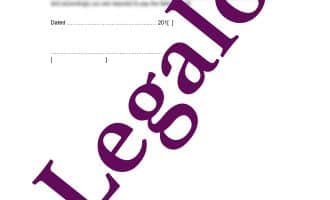Notice of Assignment of Debt
Our Notice of Assignment of a Debt template:
- Give notice of the assignment of a debt
- Solicitor-drafted notice for peace of mind
- Easy-to-edit template for fast drafting
- Less than five minutes drafting time required
- Legalo’s no quibble money-back guarantee assurance

How Does It Work?
-
1. Download
-
2. Edit
-
3. Print
-
4. Sign
Our Notice of Assignment of Debt template is for use when notifying a debtor (the person or company that owes the money) that the debt that they owe has been assigned (sold or transferred) to another individual or company.
Assigning a Debt and Giving Notice
When a debt is transferred, it is a requirement that notice is given to the debtor of the assignment, transfer or sale. This is a requirement for a legal assignment. The relevant law is section 136 of the Law of Property Act 1925. If notice has not been appropriately given, then the party to whom the debt is assigned will not be able to enforce the debt in the Courts in their own name and get a judgment order if needed. Also the debtor would still be assuming they should pay the original lender or owner of the debt. The new owner of the debt would not want that to happen.
If you’ve not yet assigned the debt, then you need to do that first. Then instead of this template, buy our template deed of Assignment of a Debt. Please note that this notice template is only the notice and does not include a deed of assignment of the debt. However, the Deed of Assignment of a Debt template does also include this notice of assignment, so you do not need to buy both.
Using Our Notice of Assignment of Debt Template
Our notice of assignment of debt template precedent is very simple to use. A UK solicitor has drafted the template, to ensure that, whilst it is short and simple, it includes all the necessary details.
We have drafted the document as a simple form. You simply need to add in the information within the square brackets that is particular to your circumstances. Delete any remaining square brackets to produce a final form notice.
Once you have completed the notice of assignment of debt, then it needs to be:
- signed by the party assigning the debt; and
- then sent to the party that owes the money (i.e. the debtor).
We recommend that you send the notice by recorded delivery i.e. “signed for”. This way you can prove in Court, should you need to, that the debtor received the notice.
A Reusable Template
As with all our templates, you buy it once. Should the need arise, you can reuse it for your own purposes as many times as you need to. Also if we ever update the notice of assignment of debt template, you will always have access to the latest version. You need never pay again to use it. Get the Legalo advantage.

FAQs on the Notice of Assignment of Debt
Below, we address the top questions on this topic from the Internet.
What is a notice of assignment of debt in the UK?
A notice of assignment of debt is a written document issued by a creditor to inform a debtor that they have legally transferred or assigned the rights of debt collection to another party, such as a collection agency or another creditor. Its purpose is to notify the debtor of the change in ownership of the debt. So then it makes it clear where future payments should be directed. This notice ensures transparency and maintains a clear record of debt ownership.
What is a notice of assignment of debt to a debtor?
A notice of assignment of debt to a debtor has the same meaning. It is a written document that a creditor issues to inform a debtor that they have legally transferred or assigned the rights of debt collection to another party, such as a collection agency or another creditor. This notice is sent by the original creditor or the assignee to:
- notify the debtor of this change; and
- provide details about where future payments should be directed.
What is a letter of assignment of debt?
A letter of assignment of debt is a written document that legally transfers the rights to collect a debt from one party to another. It is also known as a deed of assignment of debt. The original creditor sends a copy of this letter to the assignee, informing them of the debt’s transfer and providing all necessary details, including the new debtor’s information and the outstanding amount.
What is the purpose of a letter of assignment?
The purpose of a letter of assignment is to transfer the rights to collect a debt from one person to another. It serves to:
- transfer the ownership of the debt to the assignee,
- advise the assignee of the debtor’s information; and
- set out the terms of the assignment.
Who signs the notice of assignment?
In a notice of assignment, it is usually the original creditor, who signs the notice to inform the debtor of the assignment of the debt to another party. The signature of the original creditor confirms the communication and the legitimacy of the debt transfer. It is not a requirement for the assignee to sign the notice.
Who sends the notice of assignment?
The original creditor, who initially loaned money or assets to the debtor, usually sends the notice of assignment. The original creditor sends this notice to the debtor to:
- provide clarity about the change in debt ownership; and
- notify the debtor where they should direct future payments.
Is a notice of assignment of debt legally enforceable?
Yes, a notice of assignment of debt is legally enforceable in the UK. It serves as a formal notification of the transfer of debt ownership, providing transparency to the debtor. The law does not require acknowledgment by the debtor in order for the notice to be legally valid. Once the notice is properly issued, the assignee has the legal right to pursue debt collection in its own name if the debt is not repaid on time, as specified in the original credit agreement.
What are the legal requirements for assignment of debt?
The legal requirements for the assignment of debt in the UK are:
- a written agreement between the original creditor and the assignee; and
- a notice to the debtor of the assignment.
All parties must also make sure to comply with relevant consumer protection laws. Providing a notice of assignment to the debtor is essential to make the transfer legally enforceable by the assignee in its own name if the debtor defaults in repayment of the loan. The written deed of assignment should clearly state the debt details and the assignment terms.
What is a formal notice of assignment?
A formal notice of assignment is a written document you use to inform a debtor officially that they now need to make future repayments of the debt to another party. At its most basic, it includes details about the debt and the name of the new creditor. However, you can include further details, such as the bank account of the assignee into which the debtor should make payment. This notice serves to:
- provide transparency;
- establish the legitimacy of the debt transfer; and
- ensure proper communication between all parties involved in the debt collection process.
Can you assign a debt without consent?
In virtually all cases, you can assign a debt without the debtor’s explicit consent, as long as the original credit agreement does not require consent for this. (It would be very unusual if it did.) While this is true, it is a legal requirement for the debtor to be notified of the assignment through a formal notice of assignment so that the assignee can enforce the debt in court in its own name.
So generally you don’t need the debtor’s consent for the assignment to be valid, but you should always inform them of the change in ownership and where to direct future payments.
Does a notice of assignment need to be acknowledged?
A notice of assignment in the UK typically does not require acknowledgment from the debtor to be valid. Its primary purpose is to inform the debtor of the transfer of debt ownership to another party. While the law does not require an acknowledgment, it can serve as evidence that the debtor has received the notice. However, the notice itself is sufficient in itself for legal purposes.
How do you write an acknowledgement for debt?
To write an acknowledgment for debt, you should include:
- The date of the notice as well as the names and addresses of both the creditor and debtor.
- The debt amount, including any interest or fees.
- Conformation of the debtor’s acknowledgment of the debt, as well as the owed amount.
- Details of the repayment terms, including due dates, interest rates, and any previously agreed-upon payment plans.
- Signatures of both parties to confirm agreement.


